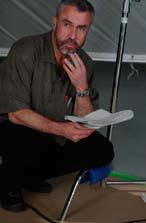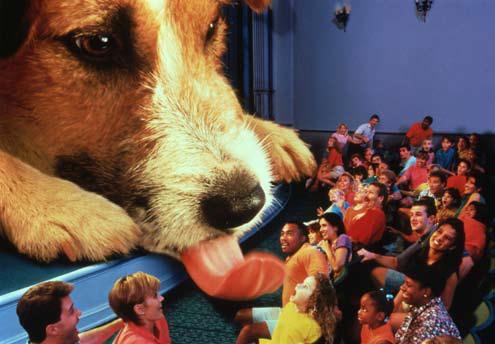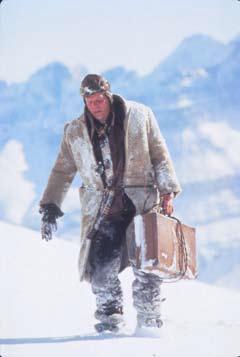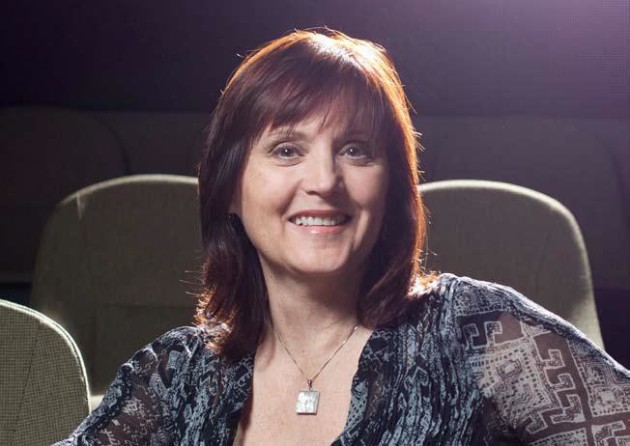Rhythm & Hues announced in September 2011 that Charlotte Huggins had joined R&H as executive producer of its Special Projects division, which will encompass Theme Park and Special Venue attractions.
With the addition of Huggins, Rhythm & Hues was poised to return to the attractions business in a big way. R&H had been a leader in the production of CG animation and visual effects for some two decades and was a leading attraction content producer during the 1990s (“It’s Tough to be a Bug!” for Disney; “Race for Atlantis” for Caesars Palace, among others).
Arguably the most experienced 3D producer on the planet, Charlotte Huggins developed and honed her skills in giant-screen, ridefilm and destination media – working with Boss Film Studio, Sony Pictures Imageworks and nWave Pictures. Virtually every one of her special venue productions is still playing somewhere in the world at a museum, theme park or world’s fair site.
“We are looking to do things that are new and interesting – bigger, better, cooler – and tell great stories.”

Huggins is fond of saying that “we can all bake a bigger pie” as a metaphor for the untapped potential of special venue cinema. She will remain active in the feature film world – “Journey to Mysterious Island” (Warner Bros.) opens in February and a third “Journey” film is rumored. Her intention is to leverage cross-platform and transmedia opportunities, and foster dialog and collaboration between the feature film and special venue camps. She sits on the New Media Council of the Producers Guild of America and the Board of Governors for the International 3D Society.
Working with Huggins on projects for Rhythm & Hues is another person familiar to the special venue community – Don MacBain, an independent producer who has collaborated with Huggins since 1990 and with R&H since 2007. MacBain’s recent credits include work on two R&H films for Ferrari World Abu Dhabi.
Rhythm & Hues’s feature work includes the “Alvin & The Chipmunks” and “Night at the Museum” franchises, along with 150+ additional film credits. R&H has won two Oscars® for Achievement in Visual Effects (“Babe” 1995 and “The Golden Compass,” 2008), along with four Scientific and Technical Awards from the Academy of Motion Picture Arts and Sciences (AMPAS).

InPark co-editor Judith Rubin interviewed Charlotte Huggins in November 2011 and found her, as usual, animated and infectiously exuberant…
IPM: How did this new career move come about?
Charlotte Huggins: I was talking to Lee Berger [President, Rhythm & Hues Feature Film division] and naming all the things I love about special venue: the people, the room for experimentation, the technology, the creative storytelling, and the fact that special venue productions stick around for a long time. One thing led to another, and here I am… I’m honored to re-ignite the special venue division that Sherry McKenna used to lead; she was my role model. We foresee three categories of projects: straightforward work for hire, partnerships and independent productions. We are looking to do things that are new and interesting – bigger, better, cooler – and tell great stories.
IPM: One of the major gratifications of special venue is the long shelf life of a production?
Huggins: Yes – there’s the joy of having it stay onscreen for 5-10 years rather than 6-12 weeks. There’s no doubt that in feature films I get to do new and interesting things, tell good stories, work with amazing people who are at the top of the industry – but a movie comes out, and – unless it’s one of only a few in history – it will never go back into theaters. “Honey, I Shrunk the Audience” which I worked on with Boss Film for Disney in 1993 was running at the Imagination! pavilion at Epcot up until about a year ago (when it was replaced by Captain EO).
[quote]If your innovation catches on beyond the initial platform, it can end up influencing bigger venues or even the broader entertainment industry. That’s exactly what happened with 3D.”[/quote]
Even “Journey to Technopia,” which I produced for the Lucky Goldstar [now LG] pavilion at Taejon Expo 93, was still playing in the original theater on the original site the last time I was there a few years ago. Creating a unique piece for a particular venue or type of venue and knowing people will enjoy watching it for years is inspiring to me.Another thing I really value about the special venue industry is that no matter what sector you are in – whether producer, distributor, or operator – you have to be involved in everything from creation through display, from the beginning to the end. And so, you get to innovate. If your innovation catches on beyond the initial platform, it can end up influencing bigger venues or even the broader entertainment industry. That’s exactly what happened with 3D.

IPM: What are you doing to jump-start yours and the company’s renewed focus on special venue?Huggins: We’re reaching out to the community in a number of ways. We’ll be at trade events, conferences and on all the PR and media channels. I’m going to the IAAPA Attractions Expo in Orlando this November and setting myself up there as a co-sponsor of the TEA (Themed Entertainment Association) booth to meet with designers, operators, distributors, producers, project managers and other potential creative partners. I’m excited to learn what projects are out there and to help create some great new guest experiences.
[quote]I think the feature film world may have a lot more to learn from special venue than the other way around!”[/quote]

We want to work with science centers, FECs, giant-screen theater owners, and theme parks large and small on computer generated, live action and hybrid projects, using a variety of business models. I want to collaborate with people rather than compete. There is a lot of room for growth and experimentation, creatively and in business.
The Giant Screen Cinema Association (GSCA) and Euromax are holding a joint film expo at Futuroscope in March 2012, and I hope to be there as well. Interestingly, the last time GSCA met at Futuroscope was when Sony and IMAX announced making the 3D feature “Wings of Courage” with director Jean-Jacques Annaud in 1995, which I had the pleasure of working on.
IPM: What did you bring to the world of features, and what are you bringing back to special venue?
Huggins: I think I can be somewhat controversial and provocative to both worlds as one of the few people who has done both.
Primarily, what I believe I took into features was the acceptance and expansion of 3D. I wasn’t the first to do 3D, nor the first to do what amounted to a ridefilm element. But to combine the two: a 3D film and a ride/attraction film essentially embedded in the feature – “Journey” was one of the first to ever do that. [The “Journey” ride/attraction films came out through Jon Corfino’s company, Attraction Media & Entertainment.] Now I see it happening more and more. I hear people in Hollywood all the time describing their feature film projects as “a thrill ride.” That makes me very happy. 3D has seriously taken off, and I think the idea of creating a ride-type experience in a movie has a real place now; it’s fun and kids like it. We are definitely doing it in “Journey to Mysterious Island.”
 What I hope to take back into special venue… First I need to say that I think the feature film world may have a lot more to learn from special venue than the other way around! The feature business has been around for a long time, and is large and established. Therefore, it has a lot of layers to it, a lot of people involved and a lot of conventions. The special venue business has neither the hierarchy nor the deep pockets. It is lighter on its feet. You are forced to be experimental and that has led us to create things that are innovative and immersive. There is a lot that I want to try in special venue that I have been watching from afar the last couple of years – such as producing for the digital dome, and creating new 4D experiences.
What I hope to take back into special venue… First I need to say that I think the feature film world may have a lot more to learn from special venue than the other way around! The feature business has been around for a long time, and is large and established. Therefore, it has a lot of layers to it, a lot of people involved and a lot of conventions. The special venue business has neither the hierarchy nor the deep pockets. It is lighter on its feet. You are forced to be experimental and that has led us to create things that are innovative and immersive. There is a lot that I want to try in special venue that I have been watching from afar the last couple of years – such as producing for the digital dome, and creating new 4D experiences.
Obviously the feature business is phenomenal in terms of talent: I would like to connect some of that from one world to the other. That would include onscreen talent, writers, directors, costumes, wardrobe, set design, and camera work.
[quote]Primarily, what I believe I took into features was the acceptance and expansion of 3D.”[/quote]
Collaboration is another great strength of the feature business, and very important it is to creating a better movie. That’s one lesson I will definitely bring. In special venue, the budgets are low, the profit potential is relatively low, and so people work more in isolation, which can be counterproductive. How do you resolve that? Make a bigger pie! Create projects that have longer legs, are more diverse and have expanded distribution potential. That means multi-platform and bigger projects. Obviously, the production budget is a direct reflection of distribution potential. No matter what industry you are in, if you can create a bigger distribution potential, you can create a bigger project. A feature film can now be seen on everything from the biggest IMAX screen to traditional theatrical exhibition to TV, HD video and your smartphone. I believe we can do that with special venue – it’s a matter of knowing how to cook up these kinds of deals.
IPM: Is there a place for going back to something like “Wings of Courage”? It was a very different kind of 3D picture from the titles you worked on later with nWave Pictures, such as “3D Mania!” and “Haunted Castle.”
Huggins: As visual effects producer for Sony on “Wings of Courage,” I had the pleasure of working directly with Peter Guber and the great Jean-Jacques Annaud. It was an extremely complicated and innovative movie at the time and is still groundbreaking today. I was not involved in the live action, which was captured in 1570 right- and left-eye photography with actors, in the mountains, on location and scripted. It was unheard of in its day and still extremely rare.
But I don’t think that people would shoot that way now; it was never easy enough or practical to work in that format. Now we have very high-resolution digital capture – 4K is coming on line as we speak – promising the ability to shoot what might be a good substitute for 1570. Meanwhile, we are creating many feature films in hi-res 2K and up every day, for giant-screen and theatrical release.
[quote]Digital capture and projection were pushed forward by special venue people and system providers such as Iwerks, ETI, Electrosonic, Barco and Christie in the 1990s – all innovators.”[/quote]
It is the giant-screen industry that brought 3D to the table. We don’t get to take credit for much because the world moves so fast, but we can say – a few dozen of us – that we were there in the early 1990s, working in 3D and creating stories and movies in 3D. That includes Sony Pictures and IMAX with “WOC” and “Across the Sea of Time,” Ben Stassen and nWave Pictures with so many titles, then and now, for a wide range of venues, and directors like John Weiley and Stephen Lowe. I give a lot of credit to the people selling IMAX 3D theaters in that time with virtually no product. We knew the power and the fun of 3D. We were creating 3D films that led directly to the feature films in 3D we are doing now.
IPM: What are some other innovations in filmmaking that have roots in special venue?
Huggins: CGI – it’s ubiquitous now, and has made a huge difference in so many films. At Boss Film, which was a big feature film effects company in its day, one of the first fully CG films they ever did was “Journey to Technopia,” and in 1993 that was very rare. We were innovating in both format and resolution. James Cameron and others in the feature world are talking about adopting 60 frames per second now, but in special venue, we have been doing 48 and 60 fps for the last 20 years. Similarly, for the past 20 years special venue has been experimenting and innovating with really tricky immersive sound systems and those are now incredibly important to the feature film experience.
Digital capture and projection were pushed forward by special venue people and system providers such as Iwerks, ETI, Electrosonic, Barco and Christie in the 1990s – all innovators.
I remember sitting with Peter Guber around 1997, talking about 3D experiences. He said, “Charlotte, you’re sitting on a surfboard and the wave is gonna come in and you’re gonna ride that wave.” I sat on my surfboard and produced a lot of interesting things, and finally, the wave did come in. It’s been the ride of my life.
Charlotte Huggins is currently writing a book about 3D pop culture, with David Cohen of Variety.






